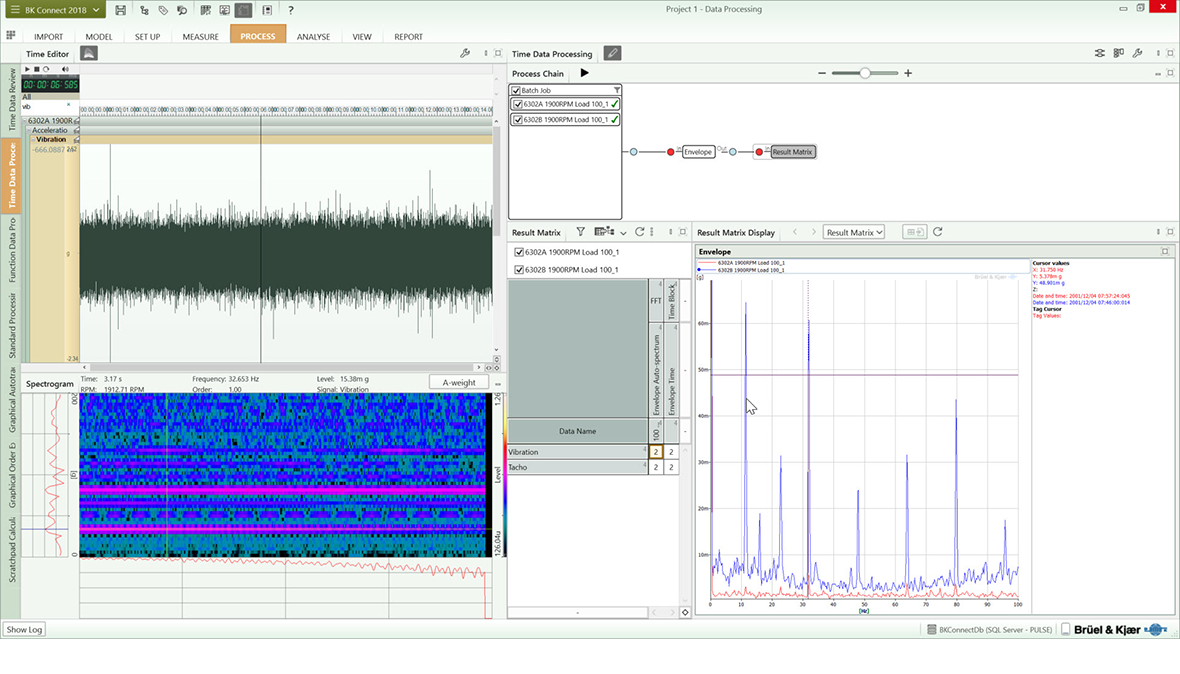Software


Type 8405-B (Replaces Type 7773) BK Connect Advanced Frequency Option
This BK Connect option adds time correlation, amplitude demodulation – or envelope analysis – and infinite impulse response (IIR) filter to BK Connect Data Processing Type 8403 or BK Connect Data Processing Specialist Type 8404 for analysis of the vibration produced by a machine. The purpose is to find changes in the vibration pattern or shock impulses caused by faults such as damage to rotating or reciprocating components. The software analyses the time signals that come from the transducers via data acquisition hardware.
USE SCENARIOS
- Fault detection in roller-bearing elements such as identifying roller defects and cracks in the inner race and outer race
- Fault detection in gearboxes, such as cracked or broken teeth
- Determination of moment in a machine’s duty cycle for the occurrence of impulsive events such as valve openings and closings, or combustion
- Identification of broken or distorted turbine blades and broken or cracked rotor bars in induction motors
CAPABILITIES
- Identification of cracks in the inner race, outer race or roller in rolling-element bearings
- Determination of impulsive modulation
- Detection of the spectral and temporal representation of the modulating signal
- Cleaner signal output
- Disambiguation of anomalies – unique instances versus delayed repetition of a single anomaly
Small faults in a machine are usually inaudible, so they are often only heard when the fault has reached excessive and critical vibration levels. These faults are hard to detect because the vibration level is modulated by the machine component speed.
Envelope and demodulation analysis
Envelope and demodulation analysis can be used where faults have an amplitude-modulating effect on the characteristic frequencies of the machinery, such as gearboxes, bearings, turbine blades, combustion engines or reciprocating machinery.
Envelope detection or amplitude demodulation is the technique of extracting the modulating signal from an amplitude-modulated signal. The result is the time history of the modulating signal. This signal may be studied and interpreted as it is in the time domain, or it may be subjected to a subsequent frequency analysis. Envelope analysis is the FFT (Fast Fourier Transform) frequency spectrum of the modulating signal.
Time correlation
Time correlation can be used when sound takes different paths and anomalies need to be identified as unique instances or delayed, repeated registering of a single original anomaly.
IIR filter
IIR is a filter that provides more detailed control than a finite impulse response (FIR) filter, for when you need a cleaner signal than can be provided by FIR.
CHARACTERISTICS
- Graphical, drag-and-drop analysis process chain
All BK Connect analyses use a graphical process-chain concept for setting up the post-recording analysis process. This includes individual elements for filtering, analysis, display and storage of results. each is individually configurable. Process chains can be exported to a file and emailed to allow others to repeat a defined, standardized process. - Automated processing
To maximize productivity, BK Connect enables batch processing of sequenced or parallel analysis of multiple sets of imported data. Time data can also be automatically imported from a network drive, and you even have the option of automatic reporting.
ADDITIONAL CAPABILITIES
This option also enables embedded recording with BK Connect Time Data Recorder Type 8402 and BK Connect Hardware Setup Type 8401.











